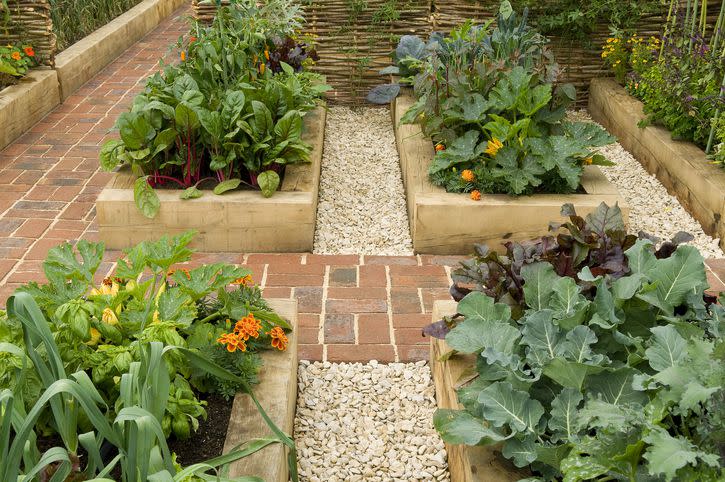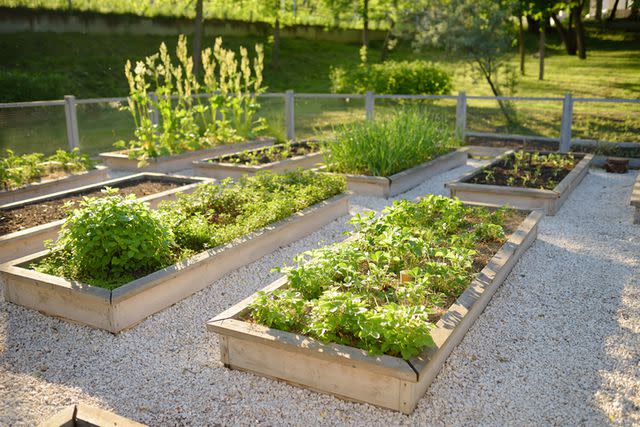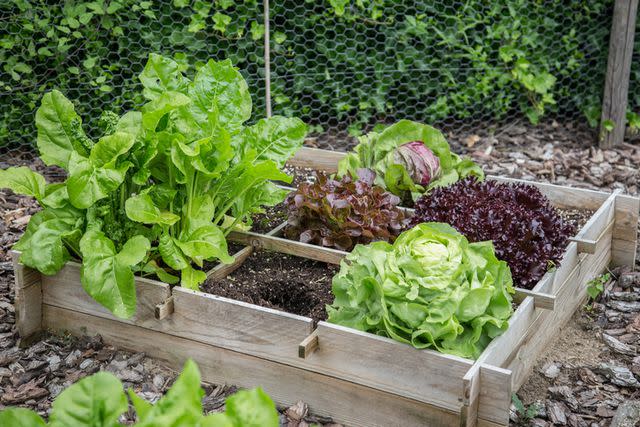How to Plan, Start, and Maintain a Kitchen Garden

David Burton / Getty Images
If you love adding a handful of basil to a homemade pizza or garnishing a quiche with a few green onions on a whim, then it's time to say goodbye to last minute grocery store trips and, instead, learn how to grow a kitchen garden. A kitchen garden is a small, functional garden that is used exclusively to grow vegetables and herbs for cooking and use within the kitchen.
Meet the Expert
Annette Hird is a horticulturist and expert gardener at Easy Urban Gardens.
"Kitchen gardens are normally located conveniently close to the kitchen of the home or commercial premises like a restaurant," says Annette Hird, a horticulturist and expert gardener at Easy Urban Gardens. "Most of the original kitchen gardens grew herbs because these could be harvested continuously just by snipping off a few sprigs here and there."
Want to start your own kitchen garden? Here's your guide for how to start, plan, and grow a kitchen garden, as well as how to continue to keep it thriving all year long.
How to Plan and Start a Kitchen Garden
Kitchen gardens come in all shapes and sizes, and your approach to planning your kitchen garden only needs to be as involved as you have time for.
The main considerations will be space, your USDA hardiness zone, sunlight and soil, and the type of plants you want to grow. Early spring is typically an ideal time to start your garden, but that can change depending on the type of plants you choose.
"To start a kitchen garden, all that's needed is a sunny spot that provides easy access from the kitchen," Hird says.
When planning, think about its proximity to your kitchen, whether the spot gets the right sun for the plants you plan on growing, and how you'll actually position the plants within the garden. Companion plants are a critical element of a successful kitchen garden.
Soil and Climate Considerations for a Kitchen Garden
Your climate and hardiness zone will determine what you can grow during different times of year, which herbs will be winter hardy, and how you'll plan your kitchen harvest. You don't have to limit your kitchen garden to spring and summer if you choose vegetables and herbs that will continue to produce throughout the winter.
Additionally, if you plan on using in-ground beds, it's helpful to test the soil to determine where it falls in terms of neutral, acidic, or alkaline, and how the nutrients are within the soil. You can always add amendments, but you need to know the baseline first. Generally, a layer of compost will add much-needed nutrients into the soil.
Choosing Raised Beds vs. Containers for Your Kitchen Garden
Kitchen gardens can be grown in raised beds, in-ground beds, or containers. In-ground beds work best when your soil is high quality or can be easily amended. You'll have to water an in-ground bed less than a raised bed or a container, but that option isn't always available depending on your soil.
With both raised beds and containers, you'll have control over the soil since you have to fill both. When it comes to decided between a raised bed or a container, think about size and effort.
"The size that you choose will determine how many different varieties you can grow," Hird says. "So, a raised bed could accommodate quite a number of different plants but with something like a 12-inch diameter pot, you're limited to just a handful of different varieties."
With raised beds or large containers, you'll need to keep in mind watering needs.
"This is especially important during summer when daily watering will be needed," Hird says. "In winter, if you live in a mild climate, watering can be reduced to whenever the top couple of inches of soil feel dry."
One final consideration is mobility. If you have mobility issues or trouble bending down, then the highest bed or container possible will make kitchen gardening easier.

SbytovaMN / Getty Images
What to Grow in a Kitchen Garden
"Start with a range of different herbs that you use often in your cooking," Hird says.
Your kitchen garden is your kitchen garden, so grow what you like. What do you gravitate towards at the farmer's market? What herb do you always find yourself reaching for while cooking? Do you crave a tomato sandwich nearly every day during the summer? You should grow the herbs and vegetables that you use and enjoy.
"Things like parsley, marjoram, thyme, oregano, basil, chives and cilantro will grow well in a kitchen garden," Hird says. "You could also include greens such as loose-leaf lettuce, spinach, kale, and swiss chard. If you want to get a bit more adventurous during the warmer months, you could also add a tomato plant, cucumbers and beans."

HildaWeges / Getty Images
Advantages of Growing a Kitchen Garden
The most obvious advantage to growing a kitchen garden is access to fresh produce right out your back door. Produce can be expensive and growing your own allows you to prepare and cook nutritious meals without a trip to the grocery store.
The other advantage is that a kitchen garden is typically smaller than a vegetable garden, making it easier to take care of and maintain. You can plant just a few vegetables or a handful of herbs — ones you know you'll use — and the maintenance is minimal.
How to Care for a Kitchen Garden
Depending on the size, a kitchen garden is typically lower maintenance than a vegetable garden. You may need to stake tomatoes, beans, and other plants that can become heavy as they grow but, typically, plants and herbs that are regularly harvested shouldn't need pruning. Plants that grow in a vine-like pattern, like cucumbers, might need to be controlled if they're impacting the plants around them.
Your watering schedule will depend on the plants that you choose. For example, mint will need to be watered regularly, while rosemary thrives in a drier environment. And don't forget about fertilizer.
"You'll need to feed your kitchen garden plants on a regular basis," Herd says. "You could either use slow-release pellets or a liquid fertilizer that you mix with water. Pellets usually only need to be replenished every four to six months, while liquid feed should be applied once every two weeks during the warmer months and around once a month during winter."
Preparing Your Kitchen Garden for Winter
Your kitchen garden can be used year round if you plant herbs and vegetables that can stand up to colder temperatures, however Hird recommends covering the kitchen garden to protect it from snow and frost.
"You could either use a cold frame or a protective type of greenhouse structure," Hird says. "Or, you could repot the plants into individual pots and then bring them indoors over winter."
Hird suggests leaving hardy vegetables like kale outside during a frost, as the leaves can actually become sweeter.
How to Protect Your Kitchen Garden From Pests
Like all edible gardens, the biggest threat to your kitchen garden is the pests that also find your plants delicious. To protect your kitchen garden from pests, you can take several steps that will deter rabbits, bugs, and other ravenous critters.
Install a fence with mesh wire and a barrier along the bottom to keep rabbits out. Make sure it's at least six feet high to stop deer too.
Plant companion plants that will help distract or repel bugs. These can be herbs and vegetables, or you can plant flowers like marigolds that attract aphids and other bugs away from your garden.
Spray neem oil or another organic insecticide to deter bugs.
Read Next: 10 Best Garden Planners, Programs, and Apps
Read the original article on The Spruce.

